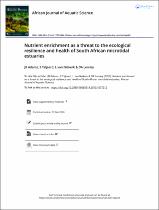 ResearchSpace
ResearchSpace
Nutrient enrichment as a threat to the ecological resilience and health of South African microtidal estuaries
JavaScript is disabled for your browser. Some features of this site may not work without it.
- ResearchSpace
- →
- Research Publications/Outputs
- →
- Journal Articles
- →
- View Item
| dc.contributor.author |
Adams, JB

|
|
| dc.contributor.author |
Taljaard, Susan

|
|
| dc.contributor.author |
Van Niekerk, Lara

|
|
| dc.contributor.author |
Lemley, DA

|
|
| dc.date.accessioned | 2020-04-28T09:06:26Z | |
| dc.date.available | 2020-04-28T09:06:26Z | |
| dc.date.issued | 2020-02 | |
| dc.identifier.citation | Adams, J.B., Taljaard, S., Van Niekerk, L and Lemley, D.A. 2020. Nutrient enrichment as a threat to the ecological resilience and health of South African microtidal estuaries. African Journal of Aquatic Science, v45(1), 18pp. | en_US |
| dc.identifier.issn | 1608-5914 | |
| dc.identifier.issn | 1727-9364 | |
| dc.identifier.uri | https://www.tandfonline.com/doi/abs/10.2989/16085914.2019.1677212 | |
| dc.identifier.uri | https://doi.org/10.2989/16085914.2019.1677212 | |
| dc.identifier.uri | http://hdl.handle.net/10204/11437 | |
| dc.description | Copyright: 2020. Taylor and Francis Online. Open Access article distributed in terms of the Creative Commons Attribution License [CC BY 4.0] | en_US |
| dc.description.abstract | Nutrient pollution in South African estuaries is described using a Driver-Pressure-State-Impact-Response framework. The root cause (‘driver’) of deteriorating water quality is rapid population growth that leads to increasing inputs from wastewater treatment works (WWTWs), stormwater run-off and agricultural return flow (‘pressures’). Nationally, half of the country’s estuaries are affected by nutrient pollution (‘state’). This has elicited marked primary producer and secondary (hypoxia, fish kills, loss of ecosystem services) responses (‘impact’). The Sundays and Swartkops Estuaries are eutrophic with phytoplankton blooms (>20 µg l-1) and bottom-water hypoxia. Similarly, the nationally important Knysna Estuary experiences eutrophic conditions associated with macroalgal blooms, whereas the Wildevoëlvlei and Zeekoe systems have transitioned to alternate stable states characterised by toxic cyanobacteria blooms, as a result of WWTW inputs and increased water residence times. The health of the St Lucia Estuary, a UNESCO World Heritage site, is under threat from agricultural inputs from the uMfolozi system. Nationally, better treatment and recycling of WWTW inputs is required to improve and restore estuary health. Owing to excessive WWTW effluent volumes, treatment to South Africa’s uniform effluent standards no longer prevent eutrophication. Other urgent interventions needed are compliance monitoring, engineering solutions to reduce stormwater and wastewater input, and prudent application of agricultural fertilisers. | en_US |
| dc.language.iso | en | en_US |
| dc.publisher | Taylor and Francis Online | en_US |
| dc.relation.ispartofseries | Worklist;23413 | |
| dc.subject | Alien invasive plants | en_US |
| dc.subject | Eutrophication | en_US |
| dc.subject | Harmful algal blooms | en_US |
| dc.subject | Macroalgae | en_US |
| dc.subject | Mouth closure | en_US |
| dc.subject | Wastewater discharges | en_US |
| dc.title | Nutrient enrichment as a threat to the ecological resilience and health of South African microtidal estuaries | en_US |
| dc.type | Article | en_US |
| dc.identifier.apacitation | Adams, J., Taljaard, S., Van Niekerk, L., & Lemley, D. (2020). Nutrient enrichment as a threat to the ecological resilience and health of South African microtidal estuaries. http://hdl.handle.net/10204/11437 | en_ZA |
| dc.identifier.chicagocitation | Adams, JB, Susan Taljaard, Lara Van Niekerk, and DA Lemley "Nutrient enrichment as a threat to the ecological resilience and health of South African microtidal estuaries." (2020) http://hdl.handle.net/10204/11437 | en_ZA |
| dc.identifier.vancouvercitation | Adams J, Taljaard S, Van Niekerk L, Lemley D. Nutrient enrichment as a threat to the ecological resilience and health of South African microtidal estuaries. 2020; http://hdl.handle.net/10204/11437. | en_ZA |
| dc.identifier.ris | TY - Article AU - Adams, JB AU - Taljaard, Susan AU - Van Niekerk, Lara AU - Lemley, DA AB - Nutrient pollution in South African estuaries is described using a Driver-Pressure-State-Impact-Response framework. The root cause (‘driver’) of deteriorating water quality is rapid population growth that leads to increasing inputs from wastewater treatment works (WWTWs), stormwater run-off and agricultural return flow (‘pressures’). Nationally, half of the country’s estuaries are affected by nutrient pollution (‘state’). This has elicited marked primary producer and secondary (hypoxia, fish kills, loss of ecosystem services) responses (‘impact’). The Sundays and Swartkops Estuaries are eutrophic with phytoplankton blooms (>20 µg l-1) and bottom-water hypoxia. Similarly, the nationally important Knysna Estuary experiences eutrophic conditions associated with macroalgal blooms, whereas the Wildevoëlvlei and Zeekoe systems have transitioned to alternate stable states characterised by toxic cyanobacteria blooms, as a result of WWTW inputs and increased water residence times. The health of the St Lucia Estuary, a UNESCO World Heritage site, is under threat from agricultural inputs from the uMfolozi system. Nationally, better treatment and recycling of WWTW inputs is required to improve and restore estuary health. Owing to excessive WWTW effluent volumes, treatment to South Africa’s uniform effluent standards no longer prevent eutrophication. Other urgent interventions needed are compliance monitoring, engineering solutions to reduce stormwater and wastewater input, and prudent application of agricultural fertilisers. DA - 2020-02 DB - ResearchSpace DP - CSIR KW - Alien invasive plants KW - Eutrophication KW - Harmful algal blooms KW - Macroalgae KW - Mouth closure KW - Wastewater discharges LK - https://researchspace.csir.co.za PY - 2020 SM - 1608-5914 SM - 1727-9364 T1 - Nutrient enrichment as a threat to the ecological resilience and health of South African microtidal estuaries TI - Nutrient enrichment as a threat to the ecological resilience and health of South African microtidal estuaries UR - http://hdl.handle.net/10204/11437 ER - | en_ZA |





